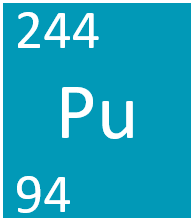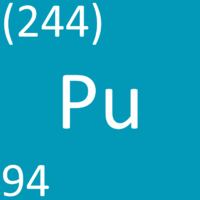Difference between revisions of "Plutonium"
(Created page with "==Key Stage 2== ===Meaning=== Plutonium is a metal. ==Key Stage 3== ===Meaning=== right|300px|thumb|The [[Chemical Symbol|chemical symbol...") |
|||
| (4 intermediate revisions by 2 users not shown) | |||
| Line 4: | Line 4: | ||
==Key Stage 3== | ==Key Stage 3== | ||
===Meaning=== | ===Meaning=== | ||
| − | [[File: | + | [[File:PlutoniumSymbol1.png|right|300px|thumb|The [[Chemical Symbol|chemical symbol]] for [[Plutonium]].]] |
[[Plutonium]] is a [[Actinide]] [[metal]] [[element]], on the [[Periodic Table]], with an [[Atomic Number|atomic number]] of 94. | [[Plutonium]] is a [[Actinide]] [[metal]] [[element]], on the [[Periodic Table]], with an [[Atomic Number|atomic number]] of 94. | ||
| Line 21: | Line 21: | ||
: [[Plutonium]] is [[ductile]]. | : [[Plutonium]] is [[ductile]]. | ||
==Key Stage 4== | ==Key Stage 4== | ||
| + | [[File:PuKS4.PNG|right|200px|thumb|The [[Chemical Symbol|chemical symbol]] for [[Plutonium]].]] | ||
===Meaning=== | ===Meaning=== | ||
[[Plutonium]] is a [[Actinide]] [[metal]] [[element]], on the [[Periodic Table]], with 94 [[proton]]s in the [[Atomic Nucleus|nucleus]]. | [[Plutonium]] is a [[Actinide]] [[metal]] [[element]], on the [[Periodic Table]], with 94 [[proton]]s in the [[Atomic Nucleus|nucleus]]. | ||
| − | ===About | + | ===About Plutonium=== |
====Molecular Structure==== | ====Molecular Structure==== | ||
: [[Plutonium]] has the [[Chemical Formula|chemical formula]] [[Plutonium|Pu]]. | : [[Plutonium]] has the [[Chemical Formula|chemical formula]] [[Plutonium|Pu]]. | ||
| Line 38: | Line 39: | ||
: [[Plutonium]] is [[sonorous]]. | : [[Plutonium]] is [[sonorous]]. | ||
: [[Plutonium]] is [[ductile]]. | : [[Plutonium]] is [[ductile]]. | ||
| + | |||
| + | |||
| + | ===References=== | ||
| + | ====AQA==== | ||
| + | |||
| + | :[https://www.amazon.co.uk/gp/product/0008158770/ref=as_li_tl?ie=UTF8&camp=1634&creative=6738&creativeASIN=0008158770&linkCode=as2&tag=nrjc-21&linkId=ec31595e720e1529e49876c3866fff6e ''Plutonium, page 128, GCSE Physics; Student Book, Collins, AQA ''] | ||
| + | :[https://www.amazon.co.uk/gp/product/019835939X/ref=as_li_tl?ie=UTF8&camp=1634&creative=6738&creativeASIN=019835939X&linkCode=as2&tag=nrjc-21&linkId=57e96876985fc39b1a3d8a3e3dc238b6 ''Plutonium, page 37, GCSE Physics; Third Edition, Oxford University Press, AQA ''] | ||
| + | :[https://www.amazon.co.uk/gp/product/178294558X/ref=as_li_tl?ie=UTF8&camp=1634&creative=6738&creativeASIN=178294558X&linkCode=as2&tag=nrjc-21&linkId=f0dfb66dafcb0c6e9449e7b1a4ae1ac362 ''Plutonium, pages 18, 49, GCSE Physics; The Revision Guide, CGP, AQA ''] | ||
| + | :[https://www.amazon.co.uk/gp/product/1782946403/ref=as_li_tl?ie=UTF8&camp=1634&creative=6738&creativeASIN=1782946403&linkCode=as2&tag=nrjc-21&linkId=32a0abb60dff015b15b50e9b1d7b4644 ''Plutonium, pages 45, 55, GCSE Combined Science Trilogy; Physics, CGP, AQA ''] | ||
| + | :[https://www.amazon.co.uk/gp/product/1782945970/ref=as_li_tl?ie=UTF8&camp=1634&creative=6738&creativeASIN=1782945970&linkCode=as2&tag=nrjc-21&linkId=a120d24dcc7cc7a58192069a3aafc1d2 ''Plutonium, pages 47, 57, 140, GCSE Physics; The Complete 9-1 Course for AQA, CGP, AQA ''] | ||
| + | |||
| + | ====OCR==== | ||
| + | :[https://www.amazon.co.uk/gp/product/0198359837/ref=as_li_tl?ie=UTF8&camp=1634&creative=6738&creativeASIN=0198359837&linkCode=as2&tag=nrjc-21&linkId=3c4229e8b023b2b60768e7ea2307cc6f ''Plutonium, pages 174, 184, Gateway GCSE Physics, Oxford, OCR ''] | ||
Latest revision as of 14:53, 5 March 2020
Contents
Key Stage 2
Meaning
Key Stage 3
Meaning
Plutonium is a Actinide metal element, on the Periodic Table, with an atomic number of 94.
About Plutonium
Molecular Structure
- Plutonium has the chemical symbol Pu.
- Plutonium atoms join together in large numbers to form a giant metal molecule.
Atomic Structure
- Plutonium as 94 protons and 150 neutrons in its nucleus giving it an Atomic Number of 94 and an atomic mass of 244.
- Plutonium is in Period 7 of the Periodic Table because it has 7 electron shells.
Properties
- Plutonium is a metal element so it is a good thermal conductor and a good electrical conductor.
- Plutonium is a shiny solid at room temperature.
- Plutonium is malleable.
- Plutonium is sonorous.
- Plutonium is ductile.
Key Stage 4
Meaning
Plutonium is a Actinide metal element, on the Periodic Table, with 94 protons in the nucleus.
About Plutonium
Molecular Structure
- Plutonium has the chemical formula Pu.
- Plutonium atoms join together in a giant metallic structure.
Atomic Structure
- The most stable isotope of Plutonium has 150 neutrons in its nucleus giving it an atomic mass of 244.
- Plutonium is in Period 7 of the Periodic Table because it has 7 electron shells.
- Plutonium loses electrons to form positive metal ions.
Properties
- Plutonium forms ionic bonds with non-metals.
- Plutonium is a metal element so it is a good thermal conductor and a good electrical conductor.
- Plutonium is a shiny solid at standard temperature and pressure and has a high melting point.
- Plutonium is malleable.
- Plutonium is sonorous.
- Plutonium is ductile.
References
AQA
- Plutonium, page 128, GCSE Physics; Student Book, Collins, AQA
- Plutonium, page 37, GCSE Physics; Third Edition, Oxford University Press, AQA
- Plutonium, pages 18, 49, GCSE Physics; The Revision Guide, CGP, AQA
- Plutonium, pages 45, 55, GCSE Combined Science Trilogy; Physics, CGP, AQA
- Plutonium, pages 47, 57, 140, GCSE Physics; The Complete 9-1 Course for AQA, CGP, AQA

